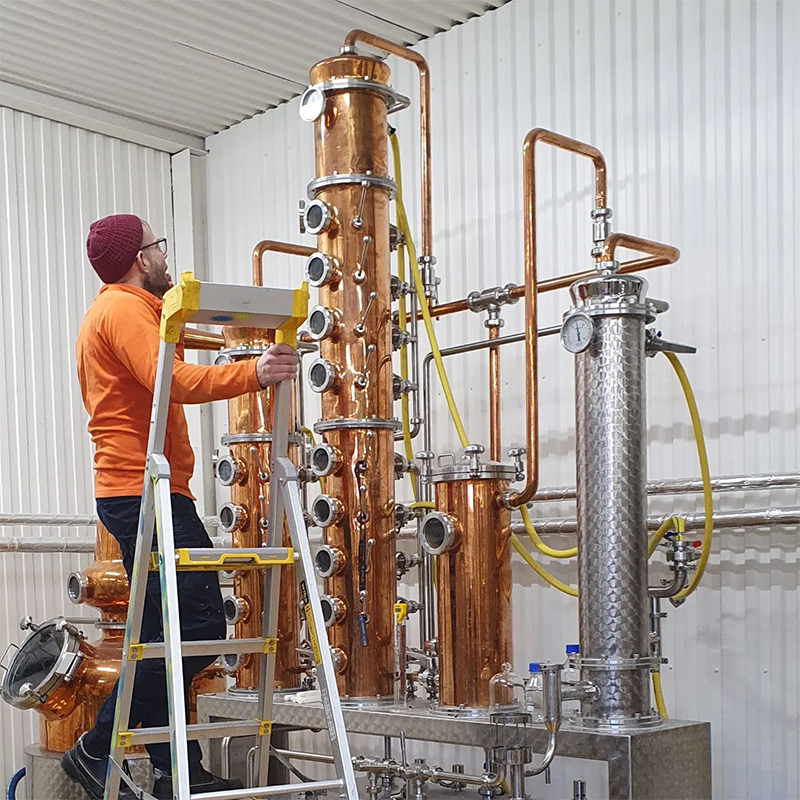
What Determines the Height and Diameter of a Column with Trays?
In the production of spirits, the distillation process is crucial to ensuring quality, consistency, and flavor. A key component in this process is the distillation column—specifically, the height and diameter of the column equipped with trays. This column plays a vital role in refining the alcohol content and separating impurities, making its design and dimensions critical for producing premium spirits.
Height of the Distillation Column
The height of a distillation column with trays is determined by the number of stages required for effective separation of alcohol from water and other components. In distillation for spirits, the primary goal is to separate the ethanol while controlling congeners—flavor compounds that give each spirit its distinctive character. Several factors influence the height of the column:
a. Separation Efficiency and Number of Trays
The more trays (or theoretical stages) a column has, the more separation steps occur as vapor rises and condenses through each tray. A taller column typically means more trays, which leads to a higher degree of separation. For spirits like whiskey or vodka, where multiple rounds of refinement are needed to reach the desired alcohol purity, a taller column helps increase the concentration of ethanol by providing additional stages for the liquid and vapor to interact.
b. Reflux Ratio
The reflux ratio—the proportion of condensed liquid that is returned to the column versus what is collected as product—directly affects column height. A higher reflux ratio can enhance separation efficiency, reducing the number of trays needed and thus decreasing the column’s height. However, for some spirits, like certain whiskies or rums, a lower reflux ratio allows more congeners to pass through, contributing to the complexity of flavors.
c. Desired Purity and Spirit Type
The type of spirit being distilled influences the column height as well. For neutral spirits like vodka or gin, where high alcohol purity is required, taller columns with more trays are often necessary. On the other hand, for spirits like whiskey or rum, where a more balanced mixture of alcohol and congeners is desired, shorter columns may suffice, with fewer trays to retain more flavor components.

Diameter of the Distillation Column
The diameter of the column determines how much vapor can pass through each tray, which directly affects the production capacity and the efficiency of the distillation process. Several factors come into play when determining the diameter of a distillation column:
a. Flow Rates and Production Volume
The volume of liquid and vapor moving through the column at any given time is a major determinant of its diameter. A larger feed or higher production output requires a wider column to handle the increased vapor and liquid flow without causing operational issues like flooding or excessive pressure drop. For large-scale distilleries aiming for high output, a wider column ensures efficient separation and avoids bottlenecks during production.
b. Vapor Velocity
The vapor velocity—the speed at which vapor moves up the column—must be carefully controlled. If vapor velocity is too high, it can lead to entrainment, where liquid is carried up with the vapor, reducing the separation efficiency. To prevent this, a wider diameter column allows for a slower, more controlled vapor flow, improving the interaction between vapor and liquid on the trays.
c. Spirit Characteristics and Congener Retention
For some spirits, retaining congeners—the compounds that add to flavor and aroma—is desirable. A narrower column may encourage the retention of these compounds by allowing vapor to rise more quickly, with less separation occurring between each tray. Wider columns, by contrast, promote a cleaner, more refined product, making them more suitable for spirits like vodka that require high purity.
For distillers, the balance between height and diameter is not only about efficiency, but also about crafting the right profile for their spirit. A shorter, wider still column will retain more congeners, giving their product a stronger flavor, while a taller, narrower still column will produce a cleaner, more refined spirit.








